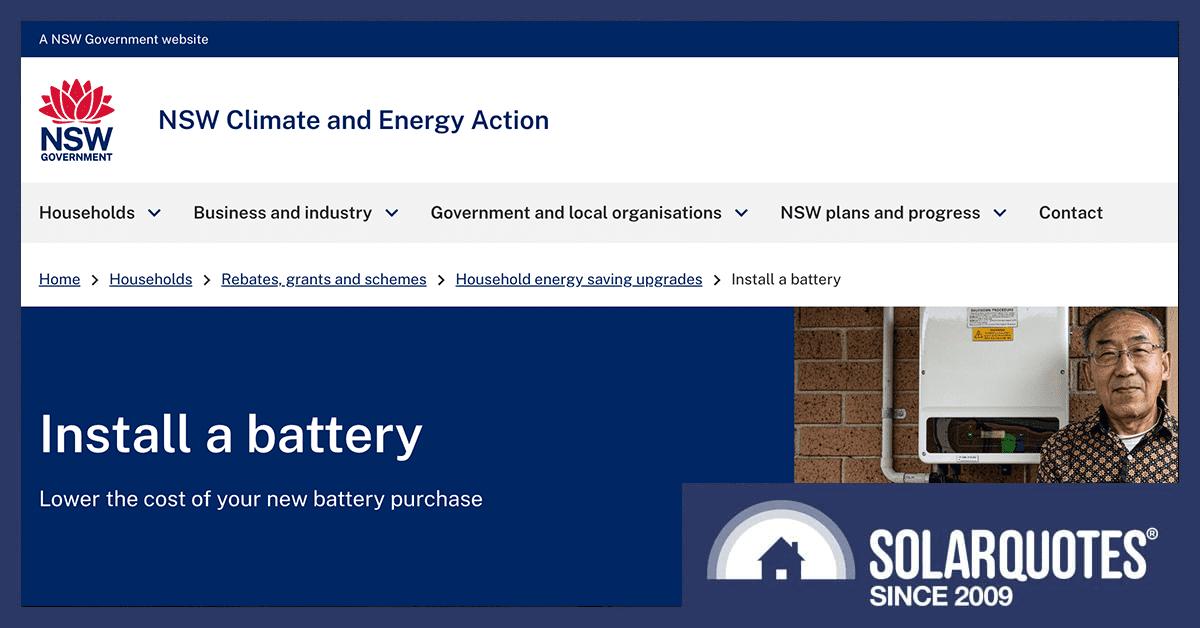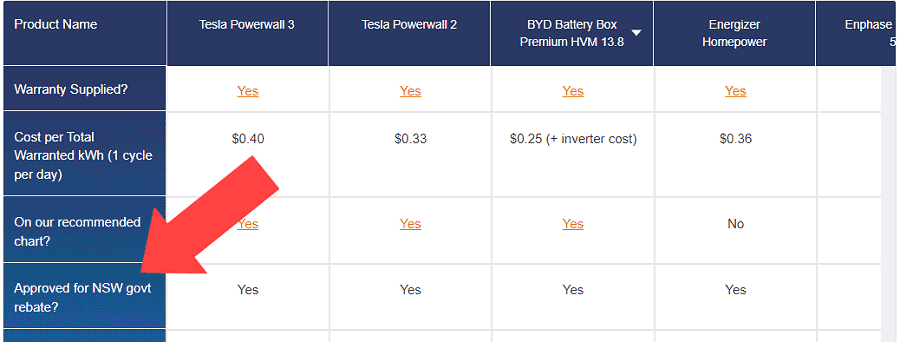Months after being announced, NSW’s battery ‘rebate’ (which isn’t technically a rebate) is due to launch on November 1st.
If you’re a homeowner looking to claim it, here’s what you need to know.
The ‘Rebate’ That Isn’t A Rebate
The coming battery rebate is part of New South Wales’ Peak Demand Reduction Scheme (PDRS) and isn’t a rebate – you are not directly getting money back from the government when you buy a battery.
Instead, your installer claims the incentive on your behalf – and passes it on to you as an up-front discount on your quote.
But it’s too bad for the NSW government because I, and everyone else, will call it a ‘rebate’. Sorry bureaucrats! Clarity is more important than semantics in this case.
What Is The Rebate Worth?
The rebate is for battery storage between 2 and 28 kWh. You can use it for multiple batteries, but be careful. If your total battery capacity is over 28 kWh, you’ll get zero rebate.
Its exact value will fluctuate based on the value of ‘Peak-demand Reduction Certificates’ (PRCs), but it’s worth about $160 per kWh at the time of writing.
For example, the 13.5 kWh Tesla Powerwall 3 attracts $2,150 in rebates with a $2 PRC price.
Connecting your battery to a Virtual Power Plant (VPP) will earn you an extra $25 per kWh.
If you sign up for a VPP later, you can claim the VPP portion of the rebate then, but you need at least 6 years remaining on the battery’s warranty.
What Batteries Are Eligible?
The NSW government has a set of quite technical criteria a battery must meet to be eligible for the scheme.
We’ve digested it into a row on our battery comparison table to advise whether a given battery is eligible.
What Do You Need To Know When Getting Quotes?
If you want to claim the NSW battery rebate, you need to use a certified installer.
They do all the paperwork on your behalf—all you’ll need to do is sign a ‘nomination form,’ which gives your installer the right to claim your rebate.
But how can you be sure an installer is certified?
If you get quotes for batteries in NSW through our service, we will only refer you to installers who can provide the rebate. Simple as that.
If you’re looking for granular details on how this scheme works – we’ve got it all on our “How To Get NSW’s ‘Solar Battery Rebate'” page.



 RSS - Posts
RSS - Posts



Thanks Finn, is there any reason the Sungrow SBR192 is missing off the list?
our bad – we’ll add it now
My battery installer ” Solar Battery Group” gets my opinion that installing additional 5.1kw battery costs 5480$ this includes 1 Eveready 5.1kWh Secondary Battery (B1-5.1-48) 4480$, Evergen Intelligent Control – No Charge, and Standard Installation 1000$, I wonder how much this attracts battery rebate? Installation thought would be cheaper than 1k. what is your thought on this please.
Hi Ratna,
It sounds like you’ll need to be careful with these providers & product. We always advise you check whatever reviews you can find.
https://www.solarquotes.com.au/installer-review/solar-battery-group/
https://www.solarquotes.com.au/battery-storage/reviews/eveready-review.html
Hey guys, the form isnt working for me
Hi Anne,
What’s it doing exactly?
I gather us early adopters with a Tesla 2 battery already, receive no benefit.
Hi Team,
Any idea if/when WA will get an upcoming battery rebate something like NSW
I deleted and unsubscribed from an unsolicited email yesterday from an “experienced Installer/engineer” offering to beat the deadline on a WA Battery Rebate of $7,000.
As I already have the maximum PVA and a comfortably sized BYD HVM 13.8kWh battery I did not investigate… but there is at least one person who seems to think there is…
BTW: with my current setup we rarely draw any grid peak power and I did not notice a recent 30 minute grid outage (except that my old office UPS beeped in protest – it was slower switching over than the house unit so is to be retired.
Cheers & thanks Finn & Co for help along the way.
Bob.
Is there any chance us Victorian’s will get a battery rebate scheme in the near future?
Finn, does your battery payback calculator account for demand tariffs? I pay more in demand charges than I do in peak period usage costs and a battery would be typically extremely effective at reducing those charges and probably significantly reducing the payback period.
Very good point Andrew,
I’ll run it past the team and see what they have built into it.
Cheers
No, Andrew, it doesn’t, but we are working on an advanced calculator that may.
If you reach out to [email protected] (Attn: Trevor re: Demand Charges), I’d love to speak with you more about this.
Hi Finn, Anthony,
Any idea about the WA battery rebates? Are they coming in or are they already here?
Regards Scott
Where can i get a full list of approved battery installers who can apply for the Rebate on my behalf
Hi Hans,
I don’t think there’s a comprehensive list available anywhere to be honest.
Click on this link and stick your details in for a quote. There’s a notes section at the end you can specify that you want a NSW battery rebate.
If you already have a battery, but are installing an additional battery(s) and will stay under the total of 28 kWh, does the “rebate” still apply?
I have the same question. One installer I approached advised the rebate would not apply but I can’t locate any official information that clearly states the same. Would be good to get some clarification.
I have the same question as well. Can anyone point to a NSW gov website that states if the rebate is applicable for add on batteries or not? Thanks.
If you have an existing battery and want to buy a new one, you are also not eligible for the rebate. We got this from the NSW government directly (via the phone).
It’s also here in the FAQs:
https://www.energy.nsw.gov.au/households/rebates-grants-and-schemes/household-energy-saving-upgrades/install-battery
Hi Finn,
I am dubious about the VPP system, do you know how long you are expected to stay connected to get the NSW rebate, if I don’t like it and want to change away from it, is there a minimum time frame that I would have to pay back the VPP incentive?
Hi John,
I don’t think the rules are clear around this but we might ask the NSW government he question and see if they can clarify. It’s been a little disappointing that they had such a long run up to the launch date but the details are still fuzzy.
Thanks for the reply, at this stage I may look to keep away from the VPP as there is just to man unknown and buyer beware situations. Im more than happy to give it a try, but if I start being out of pocket because they deplete my battery and then charge me extremely high peak tariffs it will hardly be worth it. (NSW Mid North Coast under Essential Energy is around 42c peak rate depending in supplier, over 50c with OVO, so certainly need to be careful to make sure the ROI of batteries is maximised by minimising grid draw wherever possible). I will habeve to look into it, but my bill vould easily go up $100 a month if my battery is depleted when I need it, so the VPP rebate would be useless if I can’t exit without cost.
John, I’ve heard directly from the NSW government that it is “totally up to the company offering the deal and how they want to structure it.”
So, I would ask each VPP what their requirements are around getting the rebate paid to you.
How do they approach adding more battery modules onto an existing battery? E.g. Adding another 3.2kw module to an existing sungrow.
Hi Adam,
Finn has a video on this here.
Battery state of charge needs to be reasonably similar, there’s a method to follow but they’re very straightforward.
My installer has told me they have yet to receive the incentive back from the NSW govt for any battery installs with the ‘rebate’ in the quote. Apparently, a lot of red tape to complete and submit! I wonder if this is the case across other installers?
Hi Peter,
I’ve certainly seen some rumblings from installers that the rebate is hardly worth the cost of extra compliance and red tape. It might be hyperbole but it’s certainly not easy.
We’d be better served with a simple carbon tax instead of all the certificate trading and ticket clipping that goes on now.
We had a Tesla PW2 installed on Nov 16 and paid our balance to our installing company on Nov 21 which had the incentive of $1787 deducted. GST apparently is applicable in that figure.
They deal through a separate company to do the claim but it didn’t seem to take long.
I’ve been told by a colleague who’s getting a solar & battery installation done (by Penrith Solar) that IPART, which administers the rebate, has issued updated battery installation requirements as of 2025, which mandate a one meter clearance in front of the battery. For my colleague, their battery is going on the side of the house near to a neighbouring fence, which I’d think is a pretty typical location. But this means that with their standard 900mm house to fence clearance, the thickness of the battery (188mm) only leaves 712mm from front of battery to the fence. So no rebate.
Penrith Solar has apparently only just found this out themselves and after some negotiation have agreed to split the difference with the home owners, which is a decent compromise I think.